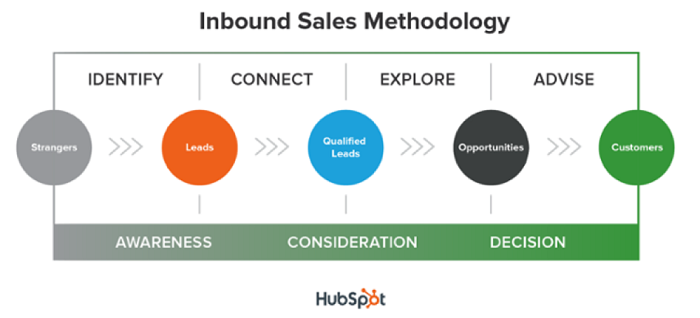Do you have a well-defined, strategic sales process? A process that enables you to identify good-fit prospects, initially connect with them and then help them to identify issues/opportunities before finally partnering or parting ways after leaving a positive impression? This blog post will introduce you to the inbound sales methodology, a systemised process designed to help you identify better-fit opportunities and close more sales. So how does inbound life science sales work?
Blog snapshot: Implementing a well-defined life science sales enablement process is vital to identifying good-fit prospects and ultimately closing more deals. The inbound sales methodology is designed to put your potential customers at the heart of the process, helping you gear your message more towards your prospects' challenges, and demonstrate how your company's product/service can help overcome them. If you would like to find out more about the inbound sales process, then why not contact our team today?
What is inbound sales?
There has been a fundamental shift in the way in which people buy in recent years. The power held by salespeople has been on the decline for a number of years now, and with buyers being better-informed than ever, traditional sales techniques are struggling to bring the same level of return as they once did. If you want to gain a competitive advantage, you have to put the buyer first—and this buyer-centric approach is what we call ‘inbound sales’. It’s not about your amazing product, it’s about identifying ways in which you can help potential prospects overcome challenges and grow, all while being seen as a true partner. The idea is to prioritise the needs of the buyer before your own.
Inbound sales helps to encourage buyers to share information with you by asking them a few key questions and really listening to their needs (even if they’re not relevant to your company). By analysing responses to your questions and gaining a better insight into the mind of your prospect, an effective inbound salesperson will be able to create a sales approach personalised to each and every buyer. Remember the job of the salesperson is to help guide a prospect through their buyer’s journey, not push them.
Simply put, the inbound sales process is split into four key steps (see below): identify, connect, explore and advise. This four-step plan starts by capturing the interest of prospects who are currently at the awareness stage of their buyer’s journey, and guides them through to becoming customers.

Step 1: Identify
The first step for creating an effective inbound sales process is to identify who would benefit from the services/products your company offers, and who would be a good fit for your company. There are two documents that will help you do this. A buyer persona template (you can get one from our free eBook on how to develop an awesome life science marketing plan) which enables you to identify and document the people you are selling to so that you can craft a tailored approach to focus on their specific needs; and a prospect fit matrix, which helps you rank the quality of leads you will be engaging with based on information such as company size, company type and income.
Once these have been created, you will have a better understanding of who is and who isn’t a good fit for your company, and you can start to build a targeted lead list of people you can help. This lead list can be populated with inbound leads gathered via your marketing activities, trigger-event leads (leads who may have been visiting your website but haven’t chosen to fill out a form), leads prospected via social platforms, and leads produced from attending events (you could also look at ghosted and lapsed leads). So long as companies fit with your buyer personas and prospect fit matrix, they should be added to your call list.
Now that you have a target lead list, it’s time to connect.
Step 2: Connect
The 'connect' step is both the most important and the most difficult part of inbound sales. The goal is to contact people on your target lead list, deliver a personalised introduction and set up step three. Many of the names on your target lead list will not be expecting your call—but this isn’t cold calling! Remember you’re here to help your carefully identified prospects. It’s not about your product or service, you just want to help companies deliver against their goals and objectives.
I recently took the opportunity to enrol in a Dan Tyre sales boot camp, and Dan provided some exceptional hands-on advice on how to best manage the connect call:
- Conduct all of your calls while standing. Be positive and smile
- Open with a simple greeting, “Hi Craig this is Dan from HubSpot”
- Don’t talk too much. Make sure you pause and listen often
- People probably won’t be expecting your call, so tell them so! “You were not expecting my call, were you?”
- Make sure you know who you are speaking with, if possible try and gauge their personality type (does this person want to chat? Do they want the facts straight away? Do you share a common interest and is that important?) and amend your approach accordingly
- Develop some opening lines post-greeting, such as “Do you travel to London a lot?” or “How do you know Craig from BioStrata?” (but make sure you are talking to the right personality type before choosing an opening line)
- Demonstrate you’ve done your research during the identify step. Provide some initial advice, highlight things on their website/social media pages that made you smile
- Look to progress things to the explore call (step three) by telling them you have some suggestions and was hoping they would have 30 minutes for you to run them through things in more detail (after all you’re here to help)
- Send the prospect a meeting invitation for the explore call while talking with them, to reduce the likelihood of someone bailing on you.
Remember, the connect call is all about helping prospects identify their problems and opportunities, and moving them towards the consideration stage of their buyer’s journey. Most of the prospects you will be speaking with at this stage are in the awareness stage, meaning you should help them name their problem or opportunity—not try and set up a demo or sell to them.
Step 3: Explore
Now that you have identified and connected with your lead, you will need to qualify them. This qualification shouldn’t be handled using the traditional BANT framework, you should be empowering the prospect to make the right decision in hiring your company or buying your product by focusing on the prospect's challenges, attributing goals to them, discussing plans that help fit with your prospect’s timelines and discussing budget. You will want to share this openly with your prospect at the start of the call to reiterate that you are not selling to this person, you have merely helped them identify an opportunity (during the connect step) and you are now assessing whether or not your company may be able to assist your prospect in taking that opportunity.
Start by addressing the challenge or opportunity you identified during step two. This is something that you will have pinned down during your research (i.e. before performing the connect call) and was the trigger that led to the explore call. Is this a challenge or opportunity that your company could help with? Be honest and realistic!
Next, assign goals to each of the challenges or opportunities. Ask questions such as “what would it mean if you could move to a digital health and safety platform instead of relying on manual, paper-based audits?”. This could spark a conversation regarding time and cost savings that your product may just be able to help with. You then can start introducing your product or service, answering the question ‘how can your company specifically help your prospect achieve these newly created goals?’. Finally, you need to assess budget. This is often a sticking point for many conversations, but transparency is key. Remember, budget doesn’t always have to be a deal-breaker. Consider all costs involved (including time- and resource-related costs) to create a compelling discussion.
Once you have qualified that the opportunity is potentially a good fit for all parties, its time to move on to the final step where you present your company as the solution to their challenge. End the call by offering the prospect a demo or presentation with all key stakeholders present, and get the invitation confirmed during the call.
Step 4: Advise
Legacy salespeople have always attempted to start with the advise step, failing to initially demonstrate how their product or service is uniquely positioned to address the needs of the buyer. Your prospect wants to know how you will specifically help them, they will not want blanket messaging on your product/service’s features. A great inbound salesperson takes generic marketing messaging and transforms it into context-driven discussions aimed at convincing the prospect that you are the right solution to help them grow.
You should start your presentation or demo by recapping all conversations to date, to demonstrate to the prospect (and additional stakeholders introduced at this stage) that you have a deep understanding of their business. This also helps provide context for the rest of your meeting. Next, connect the goals discussed during steps two and three with your product or service offering—show them exactly how they can reach their goals by partnering with your company. Finally, present an implementation timeline that determines what would happen if they started working with you the next day, instead of in six months’ time. This not only helps reinforce that your company will help them reach their goals, it also enables you to introduce a sense of urgency. Missing out or losing to the competition is a key purchasing driver, and you should communicate this through your presentation.
Why implement inbound sales?
Inbound sales operates across the buyer’s journey, helping you turn strangers into customers by following a simple four-step process. Selling is no longer about scripts, templates and blanket messaging, but instead is about truly understanding the needs of your buyers and helping them to overcome challenges by tailoring your messaging accordingly. Remember, every company that you have identified as being an ideal fit during step one wants to hear from you—and they want your help.
Are you interested in boosting the performance of your sales efforts, closing more deals and generating more revenue? Contact our team of experts today to learn more about our systemised approach to sales management, guaranteed to deliver the results you need.




